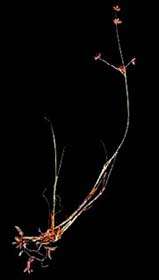Entorrhizomycetes
Entorrhizomycetes is the sole class in the phylum Entorrhizomycota within the Fungi subkingdom Dikarya along with Basidiomycota and Ascomycota. It contains three genera and is are small group of teliosporic root parasites that form galls on plants in the Juncaceae (rush) and Cyperaceae (sedge) families. Prior to 2015 this phylum was placed under the subdivision Ustilaginomycotina. A 2015 study did a "comprehensive five-gene analyses" of Entorrhiza and concluded that the former class Entorrhizomycetes is possibly either a close sister group to the rest of Dikarya or Basidiomycota.
| Entorrhizomycetes | |
|---|---|
 | |
| Galls on the roots of Juncus articulatus induced by Entorrhiza casparyana | |
| Scientific classification | |
| Kingdom: | |
| Subkingdom: | |
| Division: | Bauer (2015) [1] |
| Class: | Entorrhizomycetes |
| Type genus | |
| Entorrhiza C.A.Weber (1884) | |
| Genera | |
| |
| Synonyms | |
|
Entorrhizomycetidae Bauer & Oberwinkler 1997[3] | |
Taxonomy
Taxonomy based on the work of Wijayawardene et al. 2019[4].
- Order Talbotiomycetales Riess et al. 2015
- Family Talbotiomycetaceae Riess et al. 2015
- Genus Talbotiomyces Vánky, Bauer & Begerow 2007
- Family Talbotiomycetaceae Riess et al. 2015
- Order Entorrhizales Bauer & Oberwinkler 1997
- Family Entorrhizaceae Bauer & Oberwinkler 1997
- Genus Juncorrhiza Riess & Piątek 2019
- Genus Entorrhiza Weber 1884 [Schinzia Nägeli 1842]
- Family Entorrhizaceae Bauer & Oberwinkler 1997
gollark: This depends on your ethical system, I guess?
gollark: Of course, it's hard to tell if it was actually religiously motivated or just geopolitics with religion as an excuse.
gollark: I mean, if we count the Crusades and stuff, lots I guess?
gollark: GENERALIZING FROM ONE EXAMPLE!
gollark: I believe in the coolness of hexagons, and Satanism but ironically.
References
- Bauer R, Garnica S, Oberwinkler F, Riess K, Weiß M, Begerow D (2015). "Entorrhizomycota: A New Fungal Phylum Reveals New Perspectives on the Evolution of Fungi". PLOS ONE. 10 (7): e0128183. doi:10.1371/journal.pone.0128183. PMC 4511587. PMID 26200112.
- Begerow D, Stoll M, Bauer R (2006). "A phylogenetic hypothesis of Ustilaginomycotina based on multiple gene analyses and morphological data". Mycologia. 98 (6): 906–916. doi:10.3852/mycologia.98.6.906. PMID 17486967.
- Bauer R, Oberwinkler F, Vanky K (1997). "Ultrastructural markers and systematics in smut fungi and allied taxa". Canadian Journal of Botany. 75 (8): 1273–1314. doi:10.1139/b97-842.
- Wijayawardene, et al. (September 2018). "Notes for genera: basal clades of Fungi (including Aphelidiomycota, Basidiobolomycota, Blastocladiomycota, Calcarisporiellomycota, Caulochytriomycota, Chytridiomycota, Entomophthoromycota, Glomeromycota, Kickxellomycota, Monoblepharomycota, Mortierellomycota, Mucoromycota, Neocallimastigomycota, Olpidiomycota, Rozellomycota and Zoopagomycota)" (PDF). Fungal Diversity. 92 (1): 43–129. doi:10.1007/s13225-018-0409-5.
This article is issued from Wikipedia. The text is licensed under Creative Commons - Attribution - Sharealike. Additional terms may apply for the media files.